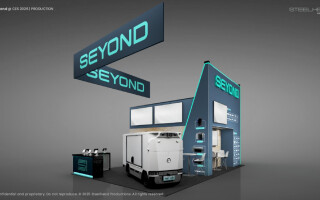CompactPCI Serial: Enhancing functionality and increasing longevity through innovation
August 01, 2012
PICMG’s latest addition to the CompactPCI family of specifications uses high-speed interfaces to modernize this proven technology platform. As m...
The true measure of technology’s value is its ability to endure the challenges of change. To persist, a technology’s configuration, hardware components, and integration strategy must possess inherent principles of flexibility, which, in turn, permit modernization and efficient enhancement.
Innovation shields technology from the obsolescence that represents a primary threat from logistical and cost perspectives. This has been particularly true for embedded computing applications. In its simplest form, technological innovation comprises research, development, testing, and implementation. However, it is not until an innovation has been introduced to the market and received widespread adoption that it will truly contribute to a technology’s longevity.
Enduring the test of time
Since its adoption by PICMG in 1995, CompactPCI, which is mechanically based on the proven Eurocard form factor, has been successfully deployed in numerous industrial, telecommunications, and military applications. An update in 2001 created the basic CompactPCI 2.0 core specification that defined form factors, the parallel bus, connectors and pin layout, power consumption, cooling, and topologies.
Innovations that followed added to the core specifications and guaranteed that more demanding industrial requirements could also adapt CompactPCI systems. These requirements included hot swap, multicomputing, rear I/O on mezzanine cards, and conduction cooling. However, within a CompactPCI system, the serial point-to-point connections are achieved through proprietary, user-defined pins on the J2 connector. This characteristic caused CompactPCI systems to be incompatible with different manufacturers’ assemblies.
Technological innovation and the system’s inherent flexibility gave rise to two newer PICMG specifications – CompactPCI PlusIO (PICMG 2.30) and CompactPCI Serial (PICMG CPCI-S.0), which define the common integration of serial high-speed signals into a modular 19" environment.
CompactPCI PlusIO is for existing systems needing to migrate from a traditional parallel architecture to serial interfaces, while CompactPCI Serial is for new systems based solely on those high-speed serial connections. CompactPCI Serial, the most recent innovation in the PICMG family of specifications, adds greater support for serial point-to-point fabrics in the classic CompactPCI form factor. Adopted in March 2011, CompactPCI Serial contains definitions for both system and peripheral slots in 3U and 6U board sizes.
Also included are definitions for eight PCI Express links, eight SATA/SAS buses, eight USB 2.0/3.0 buses, and eight Ethernet interfaces at system slots, plus signals for general system management. Ethernet is wired as a full mesh and transmission is based on proven standards for copper connections up to 10BASE-T for configuring redundant safety-critical systems.
The CompactPCI Serial specification enables the CompactPCI form factor to benefit from the latest I/O enhancements found in all modern computer chips. The specification will greatly increase the efficiency, extend the useful life, and enhance the preferred-technology status of the CompactPCI form factor for years to come (see Figure 1).
Building complete systems
As should be the case when an innovation changes the technology landscape, several product developments were introduced immediately following the adoption of CompactPCI Serial to enhance the applicability of this new specification.
For example, a family of CompactPCI Serial peripheral cards brought forth a wide array of available functionality to enable quicker, easier integration of CompactPCI Serial in embedded computing environments. These include interface cards, quad GbE or fiber-optic boards, a PCI Express (PCIe) Mini Card, and an XMC/PMC carrier board, as well as a multidisplay controller board, universal interface board, unmanaged 4+1 port Ethernet switch, and a SATA hard disk drive/solid-state disk shuttle.
These cards can be used in conjunction with readily configurable systems in a number of applications, including RAID systems, Network Attached Storage (NAS) systems, multi-CPU systems, computer clusters, safe systems, image-processing systems, graphics-output systems, and wireless communication. The cards also enable CompactPCI Serial to interconnect several boards with a high-speed connection. Both RAID and NAS systems, which normally handle large amounts of data, benefit from the assurance that information is passed quickly and accurately.
Expanded functionality for CompactPCI Serial systems
The wide range of available peripheral boards helps foster system flexibility and further the migration of legacy CompactPCI systems to updated CompactPCI Serial-based systems, thus meeting the growing demands of high-speed data transmission (see Figure 2).
For example, a 3U CompactPCI-to-CompactPCI Serial interface card can replace a system slot card, and because it is equipped with a PCIe-to-PCI bridge, it acts as a master for up to seven PCI devices, supporting 32-bit and 33 MHz configurations. The serial-based system can be connected to the legacy one. In this configuration, the CompactPCI Serial and the CompactPCI backplanes can either be located in one or two separate housings.
For applications requiring external data storage media or devices to be connected with high data transfer rate requirements such as high-speed video cameras, USB 3.0 seems to be the interface of choice. Peripheral boards that use the latest USB technology and conform to the industry-standard 3U form factor will allow video content and data management to be increasingly incorporated into embedded systems in areas as diverse as passenger information in railways and avionics or security and surveillance.
Ethernet is another aspect that is quickly forging a wider path in embedded systems. CompactPCI Serial can connect a total of nine cards in a system (one system slot, eight peripheral) through a full Ethernet mesh that supports the IEEE 802.3 Ethernet standard. The CPCI-S.0 specification is optimized for symmetrical multiprocessing and redundant system topologies. CompactPCI Serial also handles the star architecture, which is sufficient for standard computers, but full mesh is better for multicomputer systems. This way, redundant systems for safety-critical and/or highly available applications can be wired on the backplane via Ethernet.
An individual peripheral card can house as many as four 10/100/1000BASE-T Ethernet channels controlled by one Ethernet controller connected to the backplane via a x4 PCIe link. With the growing number of harsh and mobile environments using embedded computers, Ethernet-based CompactPCI Serial cards typically incorporate robust design features such as extended temperature ranges and M12 connectors.
For high-frequency mobile wireless functions including WLAN, GPS, and GSM, CompactPCI Serial peripheral cards can accommodate two PCIe Mini Cards or two ExpressCards with internal PCIe or USB, as well as two SIM cards. This gives more flexibility and helps avoid performance bottlenecks or high roaming fees, for instance when a train crosses a country border.
For the wide range of high-speed applications that mandate increased I/O, universal 3U XMC or PMC carrier boards can provide instant access to current high-speed XMC modules, as well as to legacy PMC modules of various speed types. In addition, CompactPCI Serial peripheral boards can provide flexible serial communication via an individual mix of UART and field bus interfaces. Furthermore, when a CompactPCI Serial board is equipped with a configurable FPGA IP core, the overall system benefits from nearly unlimited interface options that enable a host of computing functionalities.
Longevity through adoption and innovation
By continuously adapting to the steady and rapid flow of advancements in embedded computing systems, the CompactPCI standard has become extensively deployed and widely embraced as a technology of choice, particularly in mission-critical and harsh environment applications.
With innovative manufacturers developing a comprehensive and versatile array of interface boards for CompactPCI Serial systems in such a short time, the established and widespread adoption of this durable and versatile technology will continue well into the future.
MEN Mikro Elektronik [email protected] www.men.de
Follow: Twitter Facebook Google+







